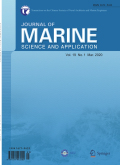- 钛学术文献服务平台 \
- 学术期刊 \
- 工业技术期刊 \
- 大学学报期刊 \
- 船舶与海洋工程学报(英文版)期刊 \
Submerged Geosynthetic Reef as Shore Protection Measure for Islands
Submerged Geosynthetic Reef as Shore Protection Measure for Islands
基本信息来源于合作网站,原文需代理用户跳转至来源网站获取
摘要:
The Sagar Island, located north of the Bay of Bengal, intercepts the flow in the Hoogly estuary that comprises a network of several estuarine distributaries and creeks, which is considered to be one of the largest estuarine systems in the world. The Hooghly River experiences a tidal range in the order of about 4 m, due to which the tide-generated currents drive the sediments which are continuously set in motion. The temple, Kapil Muni (21°38'15.35"N, 88°4'30.56"E) is located on the south-western side of Sagar Island, where an annual religious festival and rituals with about a million pilgrims is conducted. The pertinent erosion problem at a rate of about 5 m/year is prevalent at the site has considerably reduced the beach width, thereby, resulting in reduced space for religious as well as recreational activities along the coast. A novel cross-section for the proposed submerged reef using geosynthetic materials is designed considering the different site-specific, environmental, and socio-economic conditions. The submerged reef can effectively be devised to redistribute the current circulation pattern and trap the sediment for beach restoration. The performance of such a structure depends on its geometrical and structural characteristics, the location of the reef (i. e.) the water depth at the toe, distance from the coastline, wave-structure interaction, sediment transport and local morpho dynamics. The aforesaid criteria were optimized using a numerical model which predicted the average residual velocity in the site to be in the order of about 1 m/s. Owing to logistical constraints geosynthetic materials had to be employed. The detailed design of such a system arrived through numerical modelling and field measurements are presented and discussed in this paper.

推荐文章
The contribution of bacteria to organic matter in coal-measure source rocks
Coal-measure source rocks
Organic matter type
Bacteria
Monomethyl alkanes
Alkyl cyclohexane
Ecological risk assessment of surficial sediment by heavy metals from a submerged archaeology harbor
Heavy metals
Eastern harbor
Enrichment factors
Degree of contamination
Potential ecological risk
基于贝叶斯和F-measure感知机的分类器设计
分类
F-measure
不平衡数据
后验概率
准确率
实验验证
内容分析
关键词云
关键词热度
相关文献总数
(/次)
(/年)
文献信息
| 篇名 | Submerged Geosynthetic Reef as Shore Protection Measure for Islands | ||
| 来源期刊 | 船舶与海洋工程学报(英文版) | 学科 | |
| 关键词 | |||
| 年,卷(期) | 2022,(1) | 所属期刊栏目 | |
| 研究方向 | 页码范围 | 128-139 | |
| 页数 | 12页 | 分类号 | |
| 字数 | 语种 | 英文 | |
| DOI | |||
五维指标
引文网络
引文网络
二级参考文献 (0)
共引文献 (0)
参考文献 (0)
节点文献
引证文献 (0)
同被引文献 (0)
二级引证文献 (0)
2022(0)
- 参考文献(0)
- 二级参考文献(0)
- 引证文献(0)
- 二级引证文献(0)
引文网络交叉学科
相关学者/机构
期刊影响力
船舶与海洋工程学报(英文版)
主办单位:
哈尔滨工程大学
出版周期:
季刊
ISSN:
1671-9433
CN:
23-1505/T
开本:
大16开
出版地:
哈尔滨市南岗区南通大街145-1号楼
邮发代号:
14-323
创刊时间:
2002
语种:
eng
出版文献量(篇)
1019
总下载数(次)
0
总被引数(次)
2815
期刊文献
相关文献
推荐文献
- 期刊分类
- 期刊(年)
- 期刊(期)
- 期刊推荐
一般工业技术
交通运输
军事科技
冶金工业
动力工程
化学工业
原子能技术
大学学报
建筑科学
无线电电子学与电信技术
机械与仪表工业
水利工程
环境科学与安全科学
电工技术
石油与天然气工业
矿业工程
自动化技术与计算机技术
航空航天
轻工业与手工业
金属学与金属工艺
船舶与海洋工程学报(英文版)2022
船舶与海洋工程学报(英文版)2021
船舶与海洋工程学报(英文版)2020
船舶与海洋工程学报(英文版)2019
船舶与海洋工程学报(英文版)2018
船舶与海洋工程学报(英文版)2017
船舶与海洋工程学报(英文版)2016
船舶与海洋工程学报(英文版)2015
船舶与海洋工程学报(英文版)2014
船舶与海洋工程学报(英文版)2013
船舶与海洋工程学报(英文版)2012
船舶与海洋工程学报(英文版)2011
船舶与海洋工程学报(英文版)2010
船舶与海洋工程学报(英文版)2009
船舶与海洋工程学报(英文版)2008
船舶与海洋工程学报(英文版)2007
船舶与海洋工程学报(英文版)2006
船舶与海洋工程学报(英文版)2005
船舶与海洋工程学报(英文版)2004
船舶与海洋工程学报(英文版)2003
船舶与海洋工程学报(英文版)2002

 免费查重
免费查重










